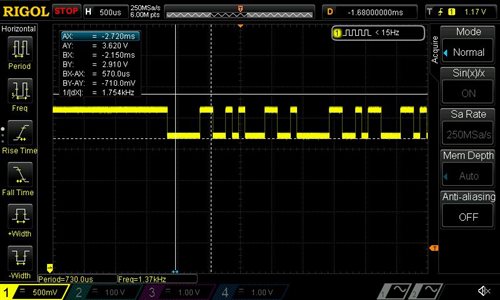I am using the SensorTag 2 Debug DevPack Rev 1.2, and have configured it to use DP4 (UART RX) and DP5 (UART TX). But for some reason the amplitude for TX is very weak, 710mV instead of 3.3V (see image)
I am using the uartecho_CC2650F128 example that comes as with TI-RTOS, And made a few changes to configure it to use the debug devpack pins (see code changes below)
I have also seen the same issue discussed here (e2e.ti.com/.../423180) but it makes no difference if I have the battery in or not. I need to have this working when debugging.
I made the following changes to board.c located in C:\ti\tirtos_simplelink_2_13_01_09\packages\ti\boards\SensorTag\CC26XXST_0120
// Changed Board_DP5_UARTTX from PIN_INPUT_EN to PIN_GPIO_OUTPUT_EN
PIN_Config BoardGpioInitTable[] = {
:
Board_DP4_UARTRX | PIN_INPUT_EN | PIN_PULLDOWN, /* DevPack */
Board_DP5_UARTTX | PIN_GPIO_OUTPUT_EN | PIN_PULLDOWN, /* Devpack */
:
};
// Changed the .txPin and .rxPin as shown below
const UARTCC26XX_HWAttrs uartCC26XXHWAttrs[CC2650_UARTCOUNT] = {
{ /* CC2650_UART0 */
.baseAddr = UART0_BASE,
.intNum = INT_UART0,
.powerMngrId = PERIPH_UART0,
.txPin = Board_DP5_UARTTX, //Board_EB_UART_TX,
.rxPin = Board_DP4_UARTRX, //Board_EB_UART_RX,
.ctsPin = PIN_UNASSIGNED,
.rtsPin = PIN_UNASSIGNED
},
};
What can I do to resolve this issue, I want to be able to use UART using the Debug DevPack pins/vias?
Glenn.



Hi Glenn,
Just had a quick question on your uartecho application ...
Have you combined that into an application with a BLE stack ... ?
When I "move" the uartecho into an app with a BLE stack, it doesn't work ...
See https://e2e.ti.com/support/wireless_connectivity/f/538/t/443701